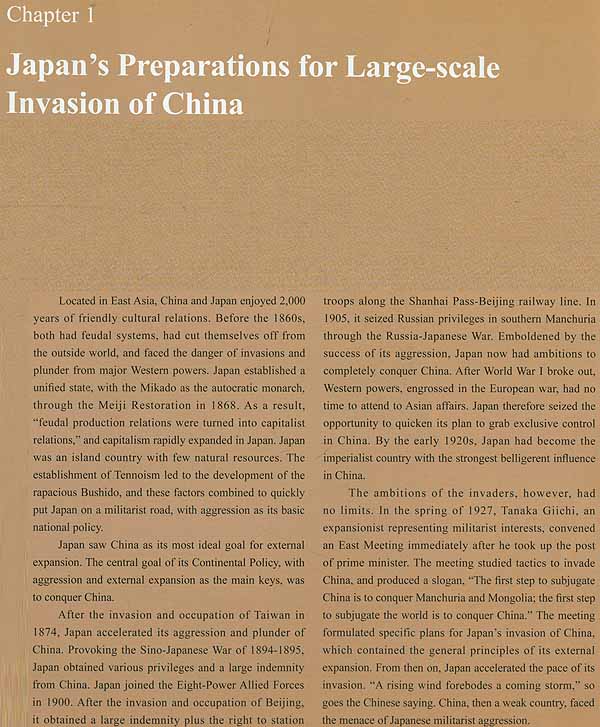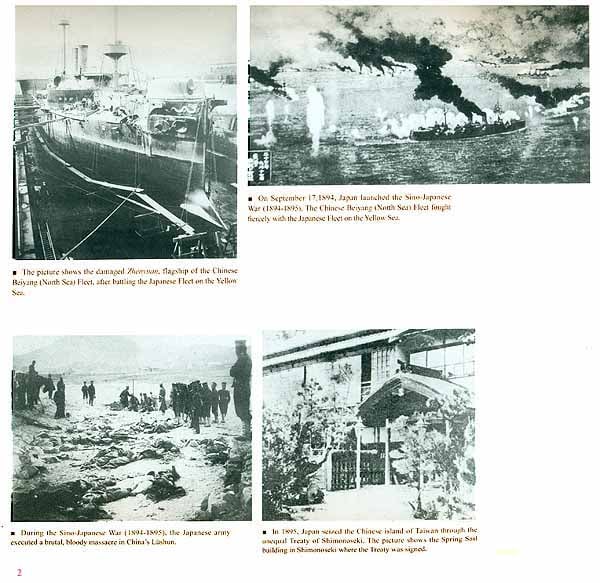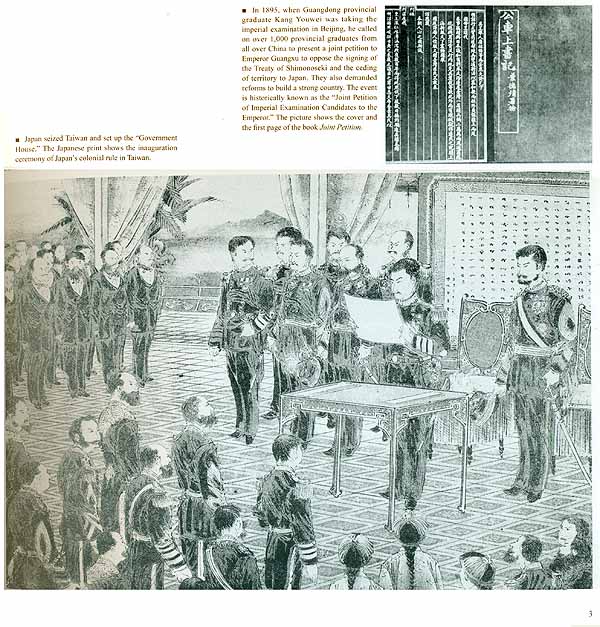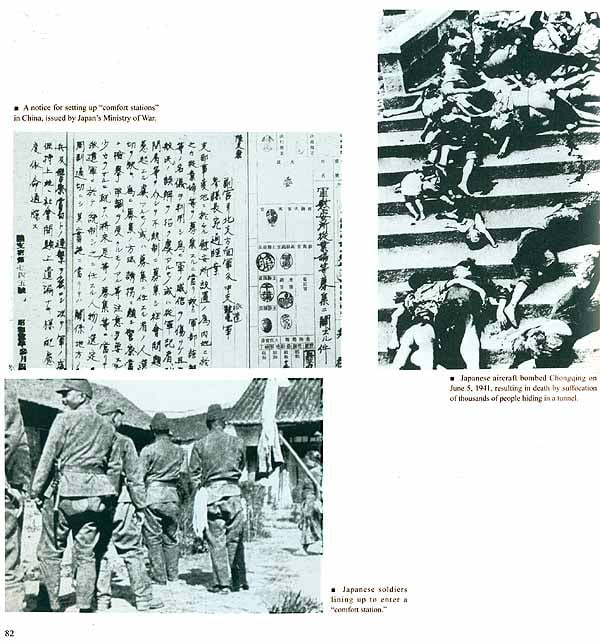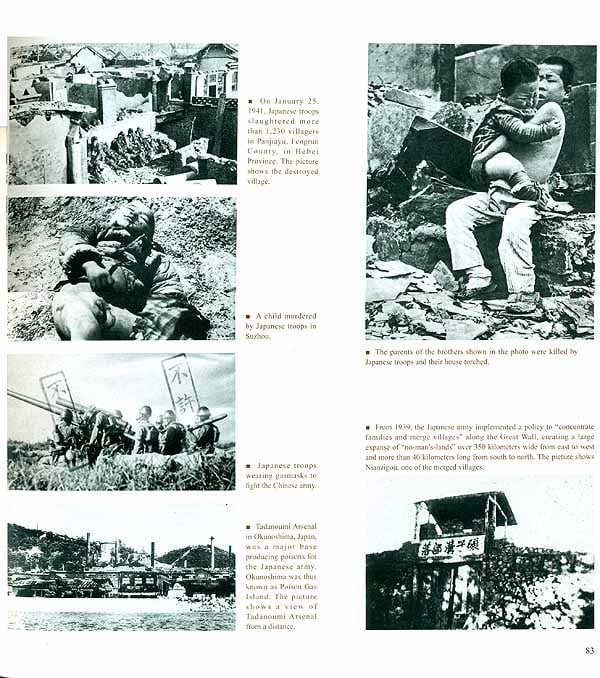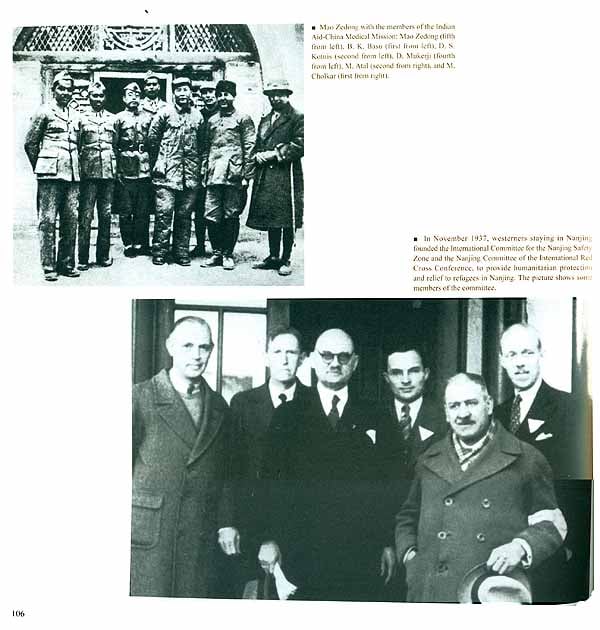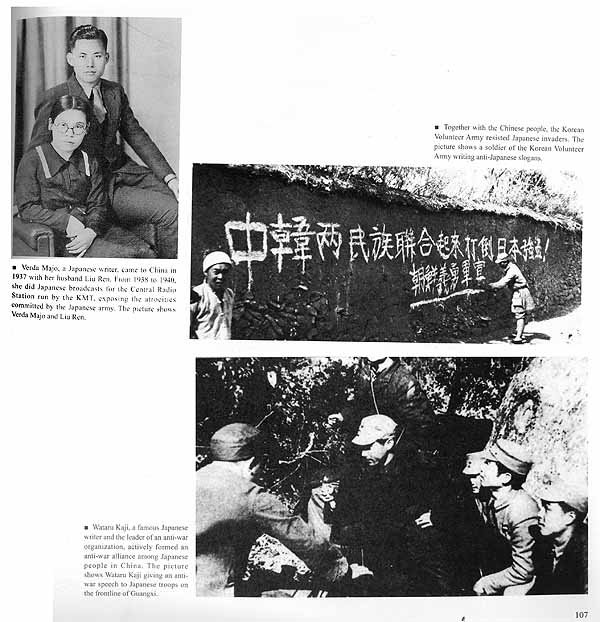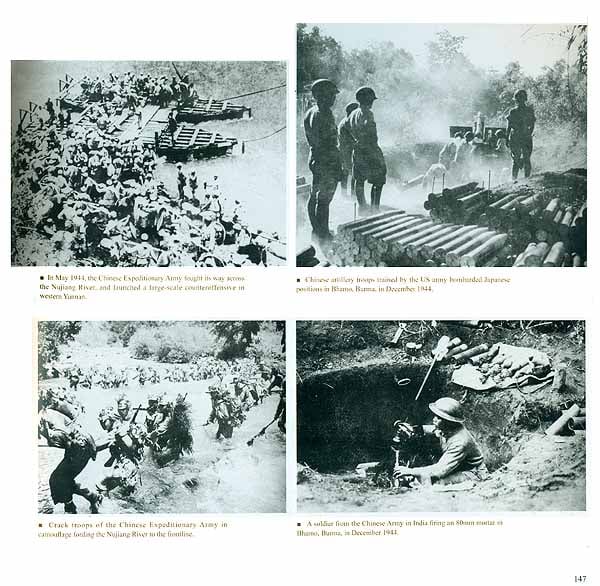
An Illustrated History of China's War of Resistance Against Japan (New Edition)
Book Specification
| Item Code: | NAN167 |
| Author: | Shen Qiang |
| Publisher: | Foreign Languages Press Co. Ltd., China |
| Language: | English |
| Edition: | 2014 |
| ISBN: | 9787119089645 |
| Pages: | 201 (7 Color and Throughout B/W Illustrations) |
| Cover: | Paperback |
| Other Details | 10.5 inch X 10.5 inc |
| Weight | 2 kg |
Book Description
With historic pictures and materials organized in chronological order, the book presents the whole process of the Chinese people's war of Resistance against Japanese aggression from 1931 to 1945. underlining the invincible spirit of the Chinese naion. Mny of the 438 pictures in the book are published for the fist time.
China's War of Resistance against Japanese Aggression laster 14 years, from September 18th incident of 1931 to Japan's surrender in sepetember 1945. The war caused 35
The War of Chinese People's Resistance Against Japanese Aggression was a great national liberation war of profound historical significance that changed the destiny of the Chinese nation, and it deserves to be kept in mind forever by the Chinese people. China was the main theater of war in the East during the World Anti-Fascist War. The Chinese people made enormous national sacrifices and contributions to the victory of the war against Fascism, which was an important event in world history. Established in 1987, the Museum of the War of Chinese People's Resistance Against Japanese Aggression is China's only large-scale memorial hall with the theme of the Chinese people's anti-Japanese war. With contributions from the museum's researchers as well as experts and scholars from China's Anti-Japanese War History Association, the museum has carried out an in- depth study of the history of the anti-Japanese war, has conducted research projects on numbers of difficult and burning issues, and has published a number of academic essays, assuming its due responsibility for popularizing the history of the anti-Japanese war, disclosing the crimes of the Japanese invaders and carrying forward the national spirit. An Illustrated History of China s War of Resistance Against Japan, published in 1995 to commemorate the 50th anniversary of the victory of that war, was one of the museum's achievements. The album introduces the process of the war. It not only reveals the aggressors' inhumanity, but also eulogizes the touching stories of Chinese soldiers and civilians who resisted the enemy with their flesh and blood. The album was published by the Foreign Languages Press in Chinese, English and Japanese, and received a warm welcome.
Nearly 20 years have passed. However, the memory of the anti-Japanese war does not fade as time goes by. On February 27,2014 the National People's Congress, China's top legislature, ratified September 3 as the day to mark victory of China's anti-Japanese war and December 13 as the national memorial day to commemorate the victims of the Nanjing Massacre. This decision was to make Chinese people remember our revolutionary predecessors' arduous fight against the Japanese imperialists' aggression, alert people to keep the past in mind while creating the future, and protect the victorious achievements of World War II and the postwar international order. On July 7, 2014 Chinese President Xi Jinping attended a ceremony to mark the 77th anniversary of the commencement of the war of Chinese people's resistance against Japanese aggression. President Xi delivered a keynote speech calling upon the Chinese people to carry forward the spirit of the anti-Japanese war, constantly promote unity as our mental bonds and the unyielding spirit as our intellectual impetus, and strive toward the Chinese Dream of the great national renewal. In the past two decades China's academic circles have carried out more extensive and in-depth studies of China's anti-Japanese war and presented fruitful achievements. And the museum has enriched its cultural relics and historical materials, and improved its research level.
To commemorate the 70th anniversary of the victory of China's anti-Japanese war, the Foreign Languages Press has decided to republish the album. We keep its structure, illustrations and captions, while incorporating new academic achievements, new views and new findings. Named An Illustrated History of China s War of Resistance Against Japan (New Edition), the book shows the Chinese people's dauntless fight against the Japanese aggression from 1931 to 1945, highlighting the joint struggle of Chinese soldiers and civilians under the anti-Japanese national united front initiated by the Communist Party of China (CPC) and based on Kuomintang- CPC cooperation. It not only showcases the Chinese nation's significant contribution to victory in the world anti-Fascist war, but also discloses the flagrant crimes committed by the Japanese aggressors.
It is an important duty for the museum to let more people learn the history of China's anti- Japanese war and enable them to better understand the unyielding resistance made by the Chinese nation. We sincerely hope that the ,new album will help readers to fully understand the war and its important role in the world anti-Fascist war. In this way, we would like to contribute to promoting the great spirit of the anti-Japanese war.
The anti-Fascist war between the 1930s and 1940s was the first just war of a global scale in human history. It ended in the Axis' unconditional surrender in 1945, 70 years ago. Over two billion people in Europe, Asia, Africa and Oceania (exceeding four-fifths of the world population at that time) were involved in the war. People who had experienced that unheard-of calamity will never forget those days when flames of battle raged everywhere.
China was the first country to fight the Fascist aggressor, experiencing the longest period of struggle, and suffering great sacrifices and heavy losses. An important part of the international anti- Fascist war, the Chinese people's War of Resistance Against Japan was closely bound up with it.
People will never forget August 15, 1945, the date on which the Japanese government issued a note to the Allied countries, announcing its unconditional surrender. Japanese militarism, the No. 2 war criminal in World War 11, collapsed. The Chinese people won the final victory in the anti- Japanese national liberation war through their bitter struggles.
China's War of Resistance Against Japan was a righteous struggle against a war of aggression provoked by Japanese militarists against the will of the Japanese people. As for the Chinese, it was an anti-aggression war to defend state sovereignty and vindicate national honour.
The War of Resistance Against Japan was a turning point in modern Chinese history. It ended the divided situation in which China found itself since the Opium War of 1840. It aroused the Chinese people, filled them with a common hatred against the enemy, and enhanced their traditional national spirit as never before. The War of Resistance changed the balance of China's political forces to a certain degree. It laid the foundation for victory in the People's War of Liberation and paved the way for the establishment of the People's Republic of China.
The War of Resistance Against Japan was not merely a struggle between the Chinese people and the Japanese militarists or merely a local war between China and Japan. Viewed from the general situation of the international anti-Fascist struggle, China's War of Resistance Against Japan was an important part of the war against aggression waged by people throughout the world, and the China theatre was a major theatre of decisive importance to World War II. China's War of Resistance strongly supported the anti-Fascist struggle in the European and Pacific theatres, disrupted the overall plan of the Japanese imperialists who attempted to dominate the world, thwarted Japan's "northward march" plot to invade the Soviet Union, and delayed its "southward march" schedule for unleashing the Pacific War. More important still, the Chinese people through great sacrifices pinned down Japan's million troops on the Chinese battlefront so that it could not enhance its military forces in the Far East and the Pacific Ocean. As a result, it greatly reduced the pressure on the Allied forces. When the Pacific War broke out, Japan's military strength totalled 2.1 million soldiers, of which 1.4 million were sent to the Chinese theatre. At this time less than 400,000 Japanese soldiers were fighting on the several-million-square- kilometre Pacific battlefield. Thus, 67 percent of the total Japanese military strength was tied up in China during the most dangerous period of the Pacific War. In other words, the Japanese military force that China (one nation) resisted trebled what more than 10 nations headed by the United States resisted. What a distinctive figure that is! If China had stopped fighting Japan, the latter would have deployed much stronger forces in the Pacific, a situation that would have led to disasters. The leaders of the Allies knew this well. Franklin D. Roosevelt, then U.S. President, once commented frankly on China's function to FrankIin D. Roosevelt, Jr., that without China, or if China had been defeated, many more Japanese divisions would have been deployed to other areas and they would have been able to occupy Australia and India immediately and without any trouble, and then push to the Middle East. Roosevelt was a commander who took part directly in the war against Japan. His words clearly showed the important role of China's War of Resistance in the international anti-Fascist struggle. For this reason alone, the China theatre became a focus of worldwide attention, raising China to a vital position in the international anti- Fascist battlefront. In the spring of 1942, the United States proposed to establish a China War Zone, and invited Chiang Kai-shek to be the supreme commander. The China War Zone consisted of the China proper, as well as Viet Nam, Thailand, Burma (now Myanmar), etc., a clear indication that the Allies relied heavily on China. Because of this, on New Year's Day, 1942, the United States, Britain and the Soviet Union united with China, and issued the United Nations Declaration. Thus, China became one of the four major anti-Fascist powers. In December 1943, China, Britain and the United States jointly issued the Cairo Declaration, which was of great historical significance. It formulated the general principles of resistance against Japanese imperialists in the anti-Fascist struggle. The Potsdam Proclamation was also jointly issued by Chinese, American and British governments in July 1945, and won wholehearted support worldwide. (The Soviet Union entered into it in August.) It sounded the death knell for the international Fascist warmongers, at the same time becoming an official denunciation against the Japanese Fascists. China's prestige and influence not only frightened the Japanese warlords, but also won for it the respect of all those people who wanted to free themselves from under the iron heel of the Fascists.
After analyzing China's great contributions to the War of Resistance Against Japan and to the world anti-Fascist struggle, we should ponder another question: China always faced failure and humiliation in its struggles against large imperialist powers since 1840; a century before the War of Resistance Against Japan, China had little ability to bear international responsibilities. Then how, by the 1940s, when Japanese imperialists were unprecedentedly strong, could China defeat this strong enemy and free itself from the abyss of misery, invasion and humiliation? After victory in the anti-Japanese war, historians approached the subject from different directions and offered various explanations. Some held that the victory was due completely to the military strength of the Allied forces. They claimed that it was the Soviet Union's dispatching troops to Northeast China and the United States dropping two atomic bombs that had changed the course of world history and, therefore, China was one of the countries liberated by the Allies. Some thought that China should attribute its victory to the Kuomintang, because its troops had effectively resisted Japanese attacks on the frontline battlefield and worn down the Japanese forces. Of course, many scholars credited the Anti- Japanese National United Front initiated by the Communist Party of China for the victory, since the Chinese people defeated Japanese imperialists under its leadership. However, since 70 years have passed, we can now understand the complete historical picture more clearly. Recent research shows that the essential reason of China's brilliant victory in the War of Resistance Against Japan laid in the fact that it was an anti-aggression war involving the whole nation. Rich fruits resulted from the great national unity under the unprecedented awakening of the entire people. The advance of patriotism and the general mobilization of the whole nation were the most important guarantees of the victory of the War of Resistance.
The Chinese nation experienced a historical progression in its awakening. Immediately after the September 18th Incident of 1931, Northeast China was reduced to the status of a Japanese colony where pillage, slaughter, enslavement and humiliation could be seen everywhere; that part of the country had become a hell on earth. People of the whole nation were deeply affected by the misery and suffering of the conquered people and the humiliation of losing their sovereignty. However, the National Government led by Chiang Kai-shek placed its hopes on international public opinion, adhering to the policy of "internal pacification before resistance to foreign invasion." However, the insatiable desires of the Japanese invaders had no limits; they stretched out their vicious hands to the Chinese territory on the southern side of the Great Wall at Shanhai Pass. In 1933, Shanhai Pass fell, and then North China faced the danger of becoming the second "Manchukuo." After the conclusion of the Tanggu Agreement and the Chin- Doihara Agreement the gate to North China was wide open. Conditions were ripe for the Japanese to start a massive invasion into the Central Plain, and the Lugouqiao (Marco Polo Bridge) Incident finally lighted the flames of Japan's full-scale invasion. The start of the war not only subjected poor people to slaughter and devastation, but the big landlords and capitalists also and even the Four Big Families faced the danger of being swallowed. The Chinese nation had reached a point where its very existence was at stake. The Chinese people at last realized that the only way to survive was to unite as one to resist Japan and save the nation from extinction. Having paid a painful price, the Chinese people realized that if China survived, the nation would prosper; if it perished, the people would die a living death. The awakening of the nation led to national unity, and the Anti-Japanese ational United Front initiated by the Communist Party soon became the banner of the Chinese people. Against the backdrop of an upsurge in the national spirit of resistance against Japan, the Kuomintang government broadcast this call: "Since the war has started, everybody across the country, old and young, is duty bound to resist Japan and defend our territory." Forgetting past resentments, the Communist Party and the Kuomintang, mutually, tried to save China from the national calamity. People throughout the country shared a bitter hatred of the enemy and pledged to resist the Japanese. With only the interests of their nation at heart, multitudes of Chinese citizens pledged to rush to the battlefields. They swept across Chinese territory, one stepping into the breach as another fell, and proceeded without hesitation to sacrifice themselves. Recognizing that saving the nation from perishing was most vital, workers, peasants, soldiers, intellectuals and businessmen, aided by popular organizations and broad masses of their overseas countrymen, resisted the Japanese with one heart and one mind. They engulfed the Japanese invaders in the boundless ocean of a people's war. Although the Kuomintang troops sustained one defeat after another on the frontline battlefield, still they resisted the Japanese at every step of the invader's advance. As a result, the enemy's troops suffered great losses. The brave, Communist-led Eighth Route Army, the New Fourth Army and many anti-Japanese guerrilla detachments operating behind enemy lines brought the resistance initiative of the masses against the Japanese into full play. They creatively carried out tunnel warfare, land mine warfare, hit-and-run warfare and independent village fighting, as well as sabotage operations. They organized armed work teams to penetrate into the enemy's centre, and struck the invaders whenever they could. Rushing about like wild beasts, and unable to extricate themselves, the Japanese invaders were in constant fear of perishing, and finally were destroyed. As proven by history, the Chinese nation is unconquerable. Once the people unite, any enemy, however strong, will be engulfed in the boundless ocean of the people's war.
The awakening and the unity of the whole nation led to an unprecedented development of patriotism. Numerous anti-Japanese heroes with lofty national integrity and an awe-inspiring national spirit set glorious examples for the people. Tong Linge, Zhao Dengyu, Zhang Zizhong, Zuo Quan, Peng Xuefeng, Dai Anlan and numerous other heroes dedicated themselves to their country's cause and went to their death unflinchingly. Their spirit fully illustrated the wonderful traditions of the Chinese nation. Their contributions to their country will be eternally glorious in history, and their noble character and sterling integrity will always inspire the people to strive bravely to strengthen the Chinese nation.
China's War of Resistance Against Japan was a nationwide war against aggression. The troops of the Kuomintang and the Communist Party fought against Japanese invaders sometimes each on their own, while at other times in coordination. Both battlefields were important components of the Chinese people's War of Resistance. However, taking a panoramic view of the eight-year history of the War of Resistance, we must point out that the Communist Party of China and the people's armed forces under its leadership played the role of mainstay in the war, in which the people's armed forces had pinned down three-fourths of the enemy forces. The Communist Party of China not only persisted in struggling behind enemy lines, but it also, by painstaking efforts, aroused the masses (including those living in areas ruled by the Kuomintang), the bourgeois democrats and all the forces that could be united to resist the invaders, until all people nationwide shared the bitter hatred of the enemy. The political influence and leading role of the Communists cannot be measured by the gains from a few military campaigns.
The War of Resistance came as a rough wave in the history of Si no-Japanese relations. China and Japan are close neighbours separated only by a strip of water. Over two thousand years of good neighbourly relations, and a long traditional friendship between the two peoples were thwarted by the war launched by Japanese militarists. Both the Chinese and Japanese peoples suffered great calamities; families were destroyed and voids were left in people's hearts. The most important thing for both nations to do is to sum up their historic experiences and draw lessons from the war so as to prevent such tragedies from recurring. As a Chinese poet wrote, "Brothers remain brothers after experiencing all the vicissitudes, and a smile when meeting casts all hatred to the winds." Only when the two peoples thoroughly and deeply understand the war can the slogan, "China and Japan will never fight each other again," come true.
Time flies like an arrow. Seventy years of history passed in the twinkling of an eye. Tremendous changes had taken place over those 70 years. China had gone through great sufferings, and finally welcomed in a new era. Today, when we are striding towards the goal of making our country strong and prosperous, we must never forget that war and martyrs who gave their lives for the cause of national liberation.
Eternal glory to the great international anti- Fascist war!
Eternal glory to the War of Resistance Against Japan!
Eternal glory to all the martyrs who laid down their lives for the just cause!
Contents
| Chapter-1 | Japan's Preparations for Large-scale Invasion of China | 1 |
| Chapter-2 | The Fall of the Three Provinces of Northeast China | 7 |
| Chapter-3 | Northern China in Imminent Danger | 19 |
| Chapter-4 | Flames of the War of Resistance Against Japan Set ablaze at Lugou Bridge | 29 |
| Chapter-5 | Fighting Dauntlessly | 45 |
| Chapter-6 | The Eight Route and New Fourth armies Boldly attack the enemy Rear Areas | 59 |
| Chapter-7 | Opposing Surrender, Secession and Retrograde Acts | 71 |
| Chapter-8 | Inhuman Atrocities of the Japanese Troops | 79 |
| Chapter-9 | Consolidating and Expanding the Battlefield Behind Enemy Lines | 87 |
| Chapter-10 | Support from People Around the World | 99 |
| Chapter-11 | China's Independent Resistance | 109 |
| Chapter-12 | Outbreak of the Pacific War | 117 |
| Chapter-13 | Anti-"Mapping-up" Operations in Anti-Japanese Base Area | 123 |
| Chapter-14 | Dauntless Resistance | 135 |
| Chapter-16 | The World's Victory Against Fascism | 155 |
| Chapter-17 | Final Victory of the anti-Japanese War | 161 |
| Chapter-18 | Acceptance of Surrender and Trial of War Criminals | 171 |
| Chapter-79 | Sino-Japanese Friendship-No More War Between the Two Countries | 181 |
| A chronology of the Events of the Chinese People's War of Resistance Against Japan | 186 |
